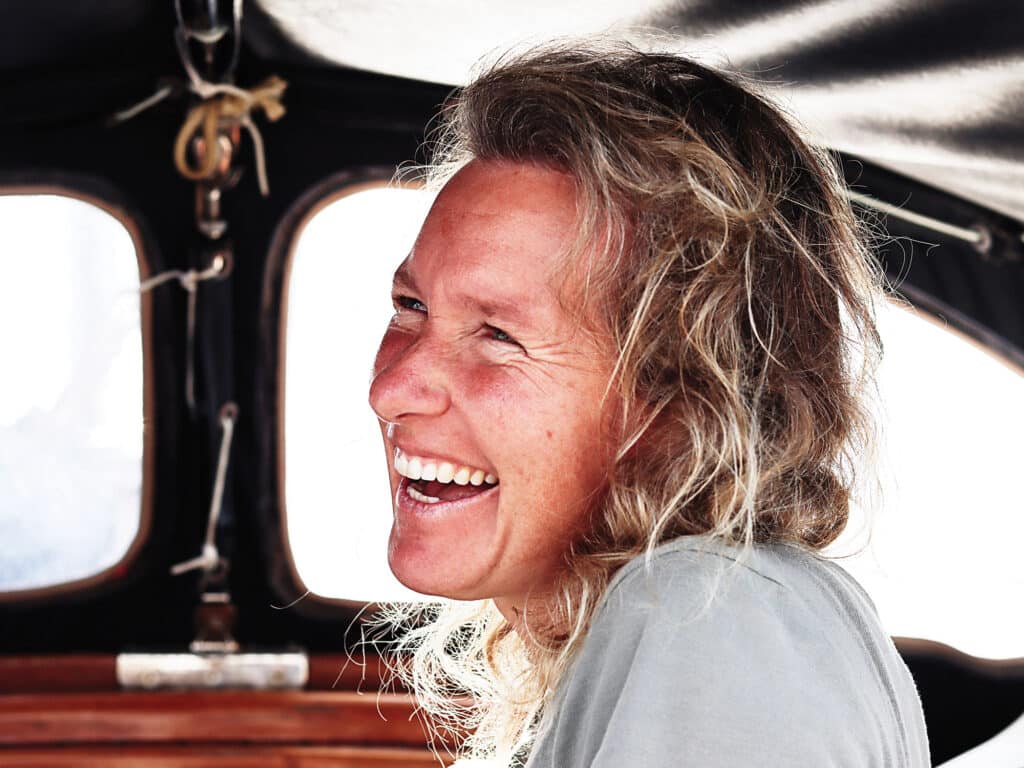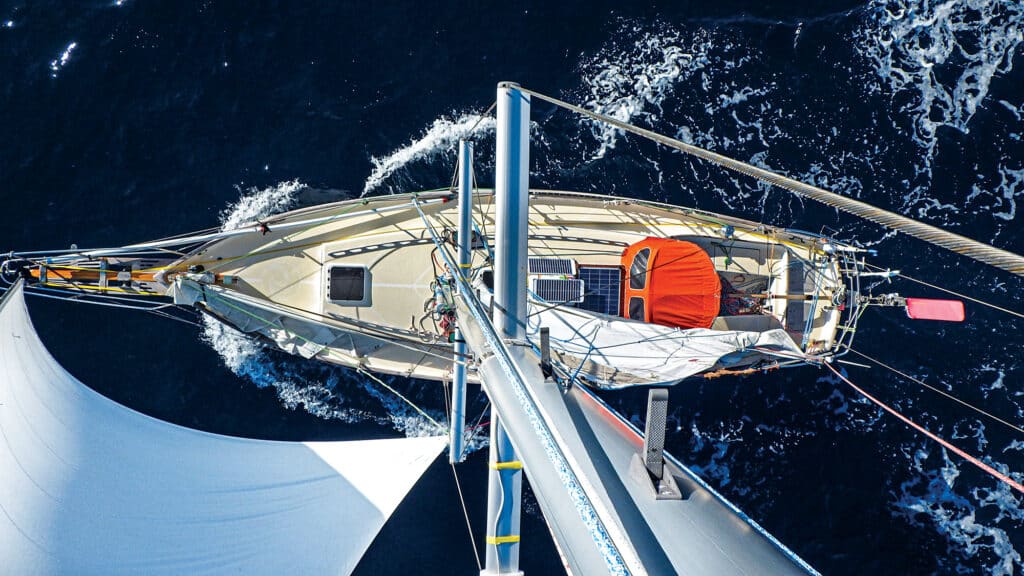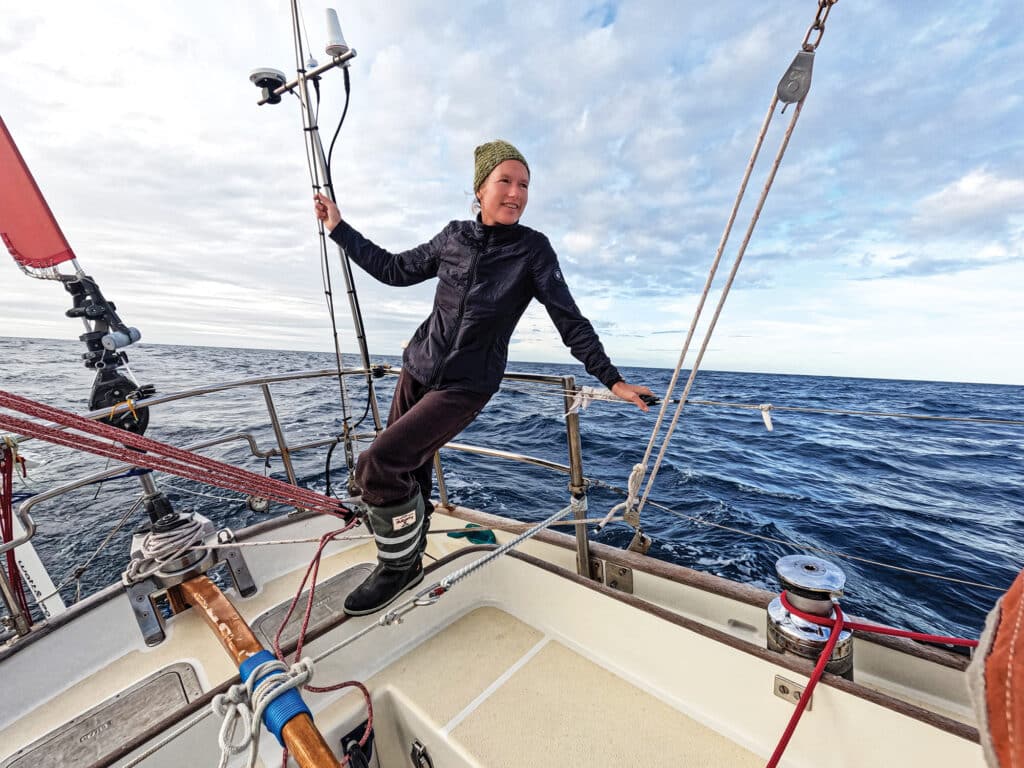
It’s early evening on April 27. The waters are calm off Les Sable d’Olonne, France, and out from the fog emerges the 36-foot cutter Minnehaha. The one soul on board is 40-year-old South African Kirsten Neuschäfer—the Golden Globe Race’s heroine and, at this moment, the first woman to win a solo around-the-world race.
Exactly 235 days earlier, as the lone female in a fleet of 16 seasoned singlehanded sailors, she’d set forth from France with a singular objective, and as she crossed the finish line, she may well have been the person least surprised by the outcome. After all, from the moment she’d entered the unique “retro” high-seas, high-stakes contest, she was in it to win it—never mind that she’d never raced offshore in her entire life.
“When I signed up for the race, I had an interesting chat with a very experienced racing sailor who asked, ‘Why are you doing it? Just to go around? Or are you doing it to win?’” she told me in the afterglow of her victory.
“And I said, ‘Well, isn’t everybody doing it to win?’ And he said, ‘No, people do it for different reasons. If you want to win, your preparation will be different. You’ll choose your boat accordingly. If you need more money, you’ll need to raise more funds. You’re going to spend much more time preparing, but your goal will be different. To win, not just sail around the world.’ And that’s how it was in my mind right from the start.”
The contemporary Golden Globe Race, having completed its second edition after an inaugural running in 2018, is a throwback “adventure race” that pays homage to the 1968 competition of the same name, won by British legend Sir Robin Knox-Johnston, the lone finisher after a voyage of 312 days, during which he became the first sailor to circle the globe alone and without stopping.
The race rules stipulate boats and equipment must strictly adhere to what was available to Knox-Johnston at the time: Competing yachts have a length overall limited to 32 to 36 feet, and they must be designed prior to 1988 with full keels and attached rudders. Satnav and related modern technologies aren’t allowed, only celestial navigation. EPIRBs and other safety gear can only be used in emergencies.
Neuschäfer may have been new to ocean racing, but she was no novice when it came to grand adventures and, for that matter, long-distance sailing. Following high school, she spent four years traveling and working in a string of outdoor pursuits: at a ski resort, training Huskies in Lapland, guiding wilderness tours in Norway. That period culminated with a solo north-to-south bike ride the length of Africa, at the conclusion of which she made a life-altering decision: to go to sea as a professional sailor.

“I was about 23,” she says, “and I started seriously clocking up miles and getting my skipper’s ticket, wanting to make a career out of it.”
For more than a dozen years, that meant delivering South African-built Leopard catamarans all over the world. “It was good practice because they were new boats and they had to arrive looking new,” she says.
Her first long solo sail was a rambling voyage with multiple stops from Portugal to South Africa aboard a 32-foot ferrocement boat, during which she learned that she enjoyed singlehanded voyaging. But her defining gig, which prepared her well for the GGR, was a five-year stint working for former Whitbread and Volvo skipper Skip Novak’s Pelagic Expeditions outfit, which conducts high-latitude charters in Arctic and Antarctic waters.
“We went to places I’d always dreamed of,” she says. “Antarctica, South Georgia, Patagonia, the Falkland Islands. It was great sailing on his boats because they were built for that sort of thing, and they were well-stocked with spares and tools, as you needed to be totally self-sufficient. We were always involved with refits because Skip wanted us to know what we were doing if we needed to fix anything. So, it was great exposure not only to maintenance and repairs, but to ice and Southern Ocean conditions.”
And it was during a crew swap in South Georgia in 2018 that she first learned of the GGR. “The mate was following the race and kept giving me updates,” she says. “Her interest was a bit contagious. I guess that’s when the seed was sown that maybe I could give it a shot myself.”
First, she needed a boat. The obvious choice was a British-built Rustler 36; six had been entered in the previous race, and they were sailed by the top-three podium finishers, including the French victor, Jean-Luc Van Den Heede. At the time, however, Neuschäfer was in Maine, and there were no Rustlers available on that side of the Atlantic. That’s when someone brought the cutter-rigged Cape George 36 to her attention.
“The numbers looked good,” she says. “It had a lot of sail area, was long on the waterline and quite heavy, but I thought that would be good for the Southern Ocean. Plus, I kind of liked the idea of doing it with another kind of boat and, you know, choosing my own path.”
She found her ride in Newfoundland and sailed it to Prince Edward Island for a refit. Minnehaha is a fictional character from Longfellow’s poem about a Native American woman entitled “The Song of Hiawatha.” The name translates to “laughing water,” and Neuschäfer came to find it quite fitting.
“It was very appropriate,” she says. “It had a nice meaning. I liked the fact that it comes from the Dakota Sioux language. I bought it in North America. It was built in Washington state. I definitely think there’s been a large stroke of Minnehaha luck through this whole venture.”
The very first stroke was meeting local jack-of-all-trades shipwright Eddie Arsenault, who became her partner and mentor in the yearlong refit to prepare Minnehaha and get the boatrace-ready. (Neuschäfer purchased the yacht for $60,000 but sunk nearly $350,000 into the campaign.)
The welcoming community of PEI proved to be a perfect place to complete the work. The hardest part, before Christmas in 2021, was leaving for her qualifying sail to South Africa. “All the mooring lines were frozen the morning I left. I had to boil water so I could defrost the lines and shove off. But it was a very good sea trial to take it all the way down to Cape Town because I got to learn the boat and realize where I still had to make repairs or improvements.”
Following more work on Minnehaha, she made a second solo passage to France for the start of the race in early September 2022. On the docks of Les Sable d’Olonne, she also began to size up her competition and identified Brit Simon Curwen and Frenchman Damien Guillou as her primary rivals. “I knew they had good racing backgrounds, and I was sitting there with none at all to speak of,” she says. “So, those were the two I was pretty worried about at first.”
A tactical error at the outset—she hugged the coast of Spain instead of heading directly offshore—left her in a distant 10th place as the fleet exited the Bay of Biscay. However, at the first of three mandatory check-in gates in the Canary Island of Lanzarote, she’d climbed back to sixth. And by taking the longer, southern route to South Africa, she was in second by the time she reached the Cape Town gate, just behind Curwen. Meanwhile, in the war of attrition that ultimately saw more than a dozen racers retire, Guillou dropped out in Cape Town with self-steering issues.
Some 450 miles from Cape Town on the stretch to the gate off Hobart, Australia, she received a message from race headquarters via her onboard tracking device that Finnish sailor Tapio Lehtinen had set off his EPIRB, abandoned his sinking boat, and was adrift in a life raft. She was the closest competitor to his position.
After calling race control with the emergency phone on board, “I opened my grab bag, unsealed my GPS and started my engine, because at first there wasn’t much wind,” she says. “But then it came through, and I put up as much sail as I could and pushed the boat as hard as I could, and helmed through the night. About 24 hours later, I got to him.”
Lehtinen was a brief visitor, and after a quick tot of rum (“Knowing he’s a Finn, I thought he’d probably enjoy that,” she says), he was quickly transferred to a cargo ship that had also arrived at the scene. (For her efforts, Neuschäfer received a 35-hour time allowance, which made her official finishing time 233 days, 20 hours, 43 minutes, 47 seconds.)
Meanwhile, Curwen was proving to be as formidable an opponent as Neuschäfer surmised, arriving at the Australian gate 29 hours ahead of her and, at one stage, opening up a lead of more than 1,000 nautical miles. But Curwen did not enjoy the Minnehaha luck and also succumbed to a self-steering failure that led to a 1,000-mile detour to Chile to effect repairs.

Meanwhile, in the deep Southern Ocean, Neuschäfer was getting into a groove, as was Minnehaha, the yacht with the fleet’s longest waterline. With her twin-rigged Yankee headsail poled out wing on wing, she was hauling the mail. “Once I got back into good winds, I had some of the best sailing I’ve ever done,” she says. “A 6-meter swell, 40 to 50 knots of wind, and the boat shooting a rooster tail off the stern, something I never thought possible for a 12-ton, 36-foot boat. So that was pretty cool.”
During this stretch, Neuschäfer set 2022 GGR records for the best four-hour average speed (9.8 knots), best 24-hour run (218.9 nautical miles) and best seven-day distance (1,216 nautical miles). The reward for her efforts? A memorable rounding of Cape Horn.
“It was maybe gusting into 35 knots, there were rain squalls, but it was all good fun,” she says. “And it was really fun speaking to the lighthouse keeper on the Horn on the VHF. He told me I was the first to pass, so that was a good boost for morale.”
From that point on, it was a two-boat race, with GGR veteran Abhilash Tomy of India hot on Neuschäfer’s heels. She endured a painfully slow crossing through the doldrums, and then sailed into a deep fog bank on her final approach through the European shipping lanes. “It was hairy but exhilarating,” she says. “Like a horse running back to the stable, the final push to the end.” With that, Minnehaha emerged from the fog, Tomy 100 miles in arrears.
“The first people arrived and told me I was first,” she says. “But it was a very slow, gentle arrival; the last 7 miles took several hours to basically just drift across the finish line. But it was such a fantastic vibe, with a lot of joy and happiness and excitement seeing all these enthusiastic people. I wasn’t expecting it—the crowds, the media attention, nothing like that. It was a once-in-a-lifetime experience.”
Neuschäfer was an immediate social media sensation, something she’s still processing. “I wouldn’t have achieved it if I hadn’t received a lot of help and random kindness from complete strangers, people I’d never met who rocked up in the perfect moment,” she says. “I feel really privileged.”
She’s anonymous no longer. “All these opportunities have opened up,” she says, with offers of sponsorship for future adventures. “I do think about what it means and hope I’m going to channel this success in a positive way. It’s quite overwhelming. I’m still trying to figure out how to channel it in the best possible way.”
Which brings us back to that triumphant night off Les Sable d’Olonne. In one way, it was a tidy conclusion to the latest excellent adventure in Neuschäfer’s eventful life. But with her race now run and her track record established, it was likely only the prelude to the next one.









